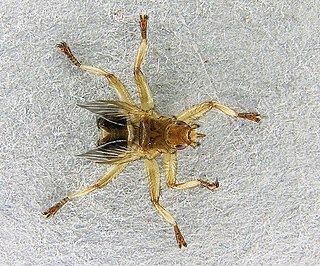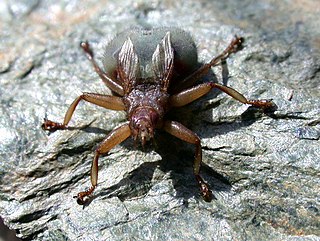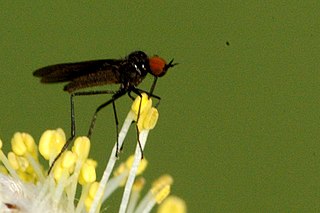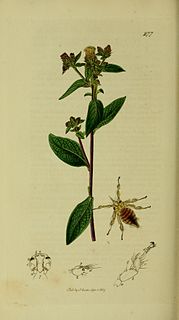
True flies are insects of the order Diptera, the name being derived from the Greek δι- di- "two", and πτερόν pteron "wing". Insects of this order use only a single pair of wings to fly, the hindwings having evolved into advanced mechanosensory organs known as halteres, which act as high-speed sensors of rotational movement and allow dipterans to perform advanced aerobatics. Diptera is a large order containing an estimated 1,000,000 species including horse-flies, crane flies, hoverflies and others, although only about 125,000 species have been described.

Calyptratae is a subsection of Schizophora in the insect order Diptera, commonly referred to as the calyptrate muscoids. It consists of those flies which possess a calypter that covers the halteres, among which are some of the most familiar of all flies, such as the house fly.

Hippoboscoidea is a superfamily of the Calyptratae. The flies in this superfamily are blood-feeding obligate parasites of their hosts. Four families are often placed here:

Hippoboscidae, the louse flies or keds, are obligate parasites of mammals and birds. In this family, the winged species can fly at least reasonably well, though others with vestigial or no wings are flightless and highly apomorphic. As usual in their superfamily Hippoboscoidea, most of the larval development takes place within the mother's body, and pupation occurs almost immediately.

Crataerina is a genus of louse flies in the family Hippoboscidae. All are parasites of birds, feeding on the blood of various species of Apodidae (swifts) and Hirundinidae. The genus is sometimes spelled Craterina.
Lipoptena mazamae, the Neotropical deer ked, is a fly from the family Hippoboscidae. They are blood-feeding parasites of the white-tailed deer - Odocoileus virginianus in the southeastern United States and Central America, the red brocket deer - Mazama americana in Mexico to northern Argentina, and also an incidental parasite of domestic cattle, Cougars - Puma concolor, and man.
Lipoptena depressa, or the Western American deer ked, is a fly from the family Hippoboscidae and 1 of 3 flies within the genus Lipotena. They are blood-feeding parasites of the mule deer - Odocoileus hemionus in the western United States and Canada particularly in regions containing the Rocky Mountains.

Hippobosca is a genus of flies in the family Hippoboscidae. There are seven known species. There are numerous synonyms.
Ornithophila are a genus of biting flies in the family of louse flies, Hippoboscidae. There are two known species. Both species are parasites of birds.

Rhamphomyia sulcata is a species of dance flies, in the fly family Empididae. It is included in the subgenus Rhamphomyia. It is found in most of Europe, except the Balkan Peninsula.

Rhamphomyia crassirostris is a species of dance flies, in the fly family Empididae. It is found in most of Europe, east to Poland and Hungary. It is absent from Italy and the Balkan Peninsula.

Rhamphomyia flava is a species of dance flies, in the fly family Empididae. It is found in most of Europe, except the Iberian Peninsula and most of the Balkan Peninsula.

Rhamphomyia nigripennis is a species of dance flies, in the fly family Empididae. It is found in most of Europe, except France, Italy, Croatia, Bosnia, Greece, Albania, Romania, Ukraine and Belarus

Rhamphomyia pilifer is a species of dance flies, in the fly family Empididae. It is found in most of Europe, except the Balkan Peninsula and the Iberian Peninsula.

Limosina silvatica is a species of fly in the family Sphaeroceridae, the lesser dung flies. It is found in the Palearctic. The larvae live in a wide range of moist decaying organic materials where they feed on micro-organisms.

Thoracochaeta brachystoma is a species of fly in the family Sphaeroceridae, the lesser dung flies. It is found in the Palearctic. Thoracochaeta brachystoma is a typical inhabitant of sea coasts. The larvae live in seaweed.

Thoracochaeta zosterae is a species of fly in the family Sphaeroceridae, the lesser dung flies. It is found in the Palearctic . Thoracochaeta zosterae is a typical inhabitant of sea coasts. The larvae live in seaweed.

Nycteribia kolenatii is a species of fly in the family Nycteribiidae. It is found in the Palearctic.

Stenepteryx hirundinis is a species of fly in the family Hippoboscidae. It is found in the Palearctic.

Ornithomya avicularia is a species of fly in the family Hippoboscidae. It is found in the Palearctic.
















